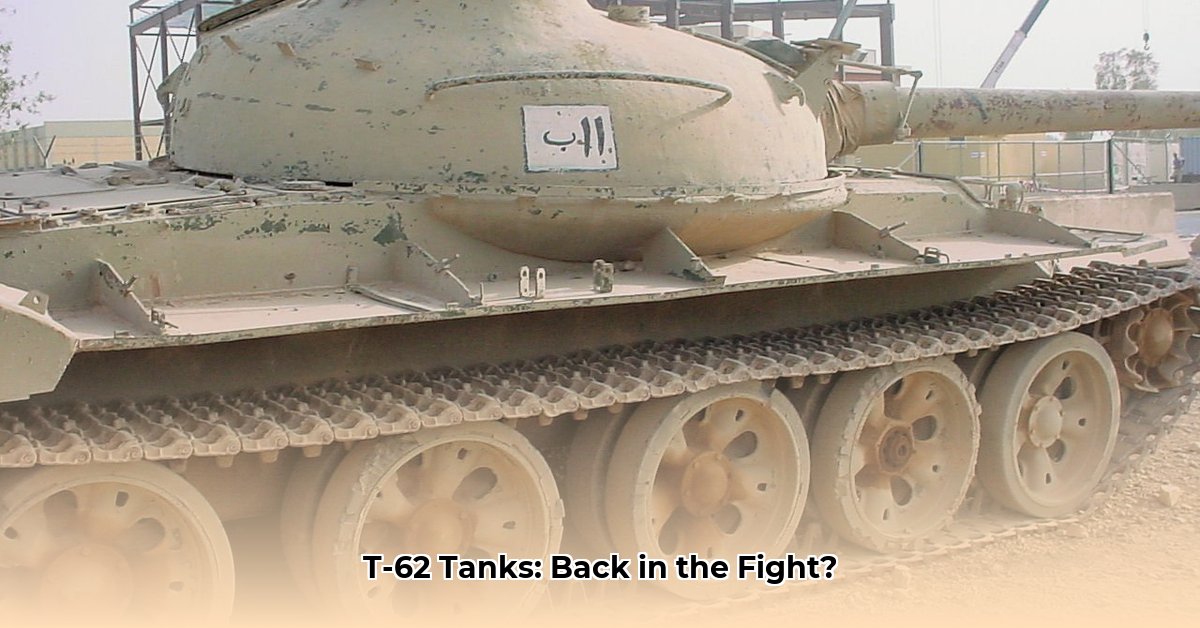
T-62 Tank Modernization: A Cold War Relic on the Modern Battlefield
Russia's ongoing war in Ukraine has necessitated unconventional military strategies, including the surprising reintroduction and modernization of hundreds of Cold War-era T-62 main battle tanks (MBTs). This article analyzes the motivations behind this program, the nature of the upgrades, and their effectiveness in the face of modern anti-tank weaponry. The deployment of these upgraded T-62s raises crucial questions about Russia's military industrial capacity and its strategic outlook. For more details on the T-62, see this page.
The T-62 Refurbishment: A Pragmatic Approach
Approximately 800 aging T-62M and T-62MV tanks are undergoing refurbishment. The key focus is enhancing survivability. Upgrades primarily include the addition of explosive reactive armor (ERA) (armor designed to detonate incoming projectiles), improved night vision systems, and enhanced communication suites. These modifications aim to counter the threats posed by Ukrainian anti-tank guided missiles (ATGMs) and other modern weapons. However, the inherent limitations of the T-62's basic design remain a significant concern.
Inherent Limitations: Can Modernization Overcome Outdated Design?
Even with upgrades, the T-62 suffers from several critical weaknesses. Its main gun is significantly less powerful and accurate than those found on modern MBTs like the Leopard 2 or Abrams. It has a relatively weak engine, resulting in poor mobility and battlefield maneuverability. Furthermore, its armor protection, even with ERA, remains significantly thinner than that of modern counterparts. This raises the question: Are these upgrades sufficient to address the fundamental shortcomings of the T-62's obsolete design?
Strategic Implications: A Reflection of Russia's Military Challenges
The scale of the T-62 modernization program reflects the challenges facing the Russian military. The decision to refurbish such large numbers of outdated tanks instead of deploying newer models suggests potential difficulties in domestic tank production, supply chain issues, and a general shortage of modern armored vehicles. "The reliance on upgraded T-62s underscores the strain on Russia’s military industrial complex," states Dr. Anya Petrova, Senior Research Fellow at the Institute for Strategic Studies, Moscow. This raises broader questions about the long-term sustainability of Russia’s military capabilities.
Battlefield Performance: A Mixed Bag
The effectiveness of the upgraded T-62s remains a subject of ongoing debate. While the ERA likely provides enhanced protection against some ATGMs, its efficacy against advanced weaponry remains uncertain. The improved targeting systems offer a marginal advantage in specific combat scenarios, but the T-62’s inherent limitations, such as its shorter range and lower accuracy compared to newer tanks, significantly impact its effectiveness. Their performance is likely highly dependent on tactical deployments and surprise engagements.
The Human Cost: A Risky Gamble for Russian Soldiers
The deployment of older, less-protected tanks presents a significant risk to Russian tank crews. The T-62's design offers less crew protection than modern tanks, increasing the likelihood of fatalities or severe injuries in combat. The implications for Russia's military manpower and morale are significant. This decision highlights a concerning prioritization of material resources over the well-being of its soldiers.
Conclusion: A Temporary Fix, Not a Long-Term Solution
While the T-62 modernization program offers a temporary, albeit risky, solution to Russia's tank losses, it is not a sustainable long-term strategy. The upgraded tanks are unlikely to significantly alter the overall trajectory of the conflict. Furthermore, the reliance on such outdated technology underscores Russia's difficulties in producing and maintaining modern military hardware. The program, therefore, serves as a stark testament to the limitations of Russia’s current military industrial capacity and its strategic challenges. The program's long-term impact, however, will be a function of its continued deployment and the evolution of battlefield technologies in Ukraine.